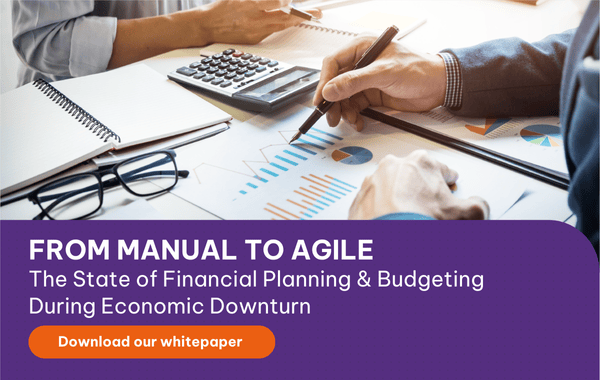A typical finance professional spends the majority of his or her time collecting, validating, and administering data, leaving a tiny window for value-added analysis. CFOs demand forecasts to be accurate, timely, and relevant. Yet, the finance department struggles to satisfy such requests.
It is a fact that the process of financial planning eats up a big chunk of time and resources. If done well, financial planning can deliver a positive ROI and drive business values.
Let's take a look at some of the best practices in financial planning.

5 best practices in financial planning
1. Turn strategies into actionable plans
Did you know that sixty per cent of organisations do not connect execution plans with their strategy?
A business strategy acts as a guideline on how the business would move into the future. Whether the strategy is a well-written document attached in a three-ring binder or it is explained informally, the most successful companies are those that are able to turn those strategies into actions.
A recommended method is to break down the entire strategy into smaller initiatives with a specified time frame and then have dedicated action plans for each initiative. By breaking it down into smaller pieces, it will be easier for businesses to adjust their long-term strategy when required.
Businesses need to make an effort in tracking and measuring the success of these initiatives and cross-checking them against the annual targets. Having a healthy data culture helps employees to facilitate conversation and link data with planning to evaluate their on-hand projects. By doing so, companies will have a better view of how well they are currently performing.
Read more: The Role of Financial Planning in Recession-Proofing Your Business
2. Understand how operational plans drive financial results
There is a direct link between operational planning and financial outcomes. For example, if we take a look at the relationship between productivity and cost of goods sold (COGS), the level of increased productivity will subsequently result in a reduction in COGS, and along with it, a rise in business earnings.
Finance professionals need to comprehend and acknowledge this relationship to develop a dynamic, integrated, and flexible financial plan that enables CFOs to respond faster to changing environment.
Continuous forecasting and planning processes should not be perceived as a burden. It empowers employees to gain deeper visibility into the current financial performance and understand critical metric insights.
Read more: Fixed forecasting vs. Rolling forecasting – Which one is right for you?
Financial results in addition to KPIs, goals, progress, and statuses of initiatives all can be monitored via a dashboard. As a matter of fact, businesses should closely monitor these metrics to keep up-to-date on all the recent changes.
Modern planning tools come with built-in role-based dashboards, allowing users to view and drill data down to the item level to support users’ responsibilities, managers and CFOs to approve budgets quickly, plan or make decisions at a glance.
3. Carefully sort out adequate resources
Resources mentioned here include budget, staffing, and time. Having enough time and budget are critical to the success of planning, but without skilled employees, businesses' initiatives cannot be carried out, and goals cannot be met.
Leading enterprises invest in optimising not only capital planning but also workforce planning to ensure maximum accuracy and consistency across the organisation. The financial strategy and plans will go to waste if the employees are not made aware of the recent tax changes, new rules, or the latest procedures.
This further emphasises the need for interdepartmental collaboration through a social platform and a database to provide a single source of the truth to aid businesses in such instances.
Giving your employees access to accurate data can increase both their effectiveness as well as their efficiency.
Read more: 3 constraints facing today’s finance professionals
4. Test out all possible what-if scenarios
Various modern accounting software systems available in the market today offer functions that allow managers to test out the worst possible situations that would happen.
Leveraging advanced technologies empower finance professionals to go beyond the usual spreadsheets and tap into analytical tools that can add more value to the planning process.
The what-if tests are useful in helping employees to comprehend how certain factors can impact the overall results and eventually deteriorate or enhance the business' profit.
Having quantifiable results from these tests help CFOs to prepare for the uncertain future, and mitigate risks, thus, empowering them to make sound decisions without feeling like embarking on the adventure of a lifetime into the unknown.
5. Connect with people and employ technology
One of the biggest pitfalls that make financial planning ineffective is the disconnected relationship between the finance function and other departments.
Establishing a good relationship with those outside the finance/ accounting border is critical, and not only that, CFOs and other financial professionals have to understand the situation of the departments that finance is supporting.
The reason is that financial planning has moved away from the manual, spreadsheet-based to a more continuous, integrated, bottom-up procedure to support the cross-organisation decision-making process.
Read more: How Infor SunSystems 6.4 can supercharge your digital transformation
The traditional planning method was lengthy and rigid, which makes organisations unable to compete in today's VUCA world. The new planning and budgeting process leveraging advanced technologies offers managers and CFOs a more streamlined approach, allowing them to set up a model of how business should look and act through a deep understanding of the key variations, business drivers and indicators. Thus, companies can continually monitor every function while adjusting the business plan accordingly as the market evolves.
Best-performing organisations make full use of technologies by implementing them in every aspect of the financing, from reporting to planning, budgeting, analysing, and forecasting. It is recommended that businesses implement a solution that comes with project management capability to take control of where the company is heading.
After reading through this article, you may think that your company is far from being “the best practice.” However, small steps count too, and dedicating your time and effort to researching a suitable solution to standardise and automate your finance and accounting function is not as frightening as they sound.
 English
English  Vietnamese
Vietnamese 



